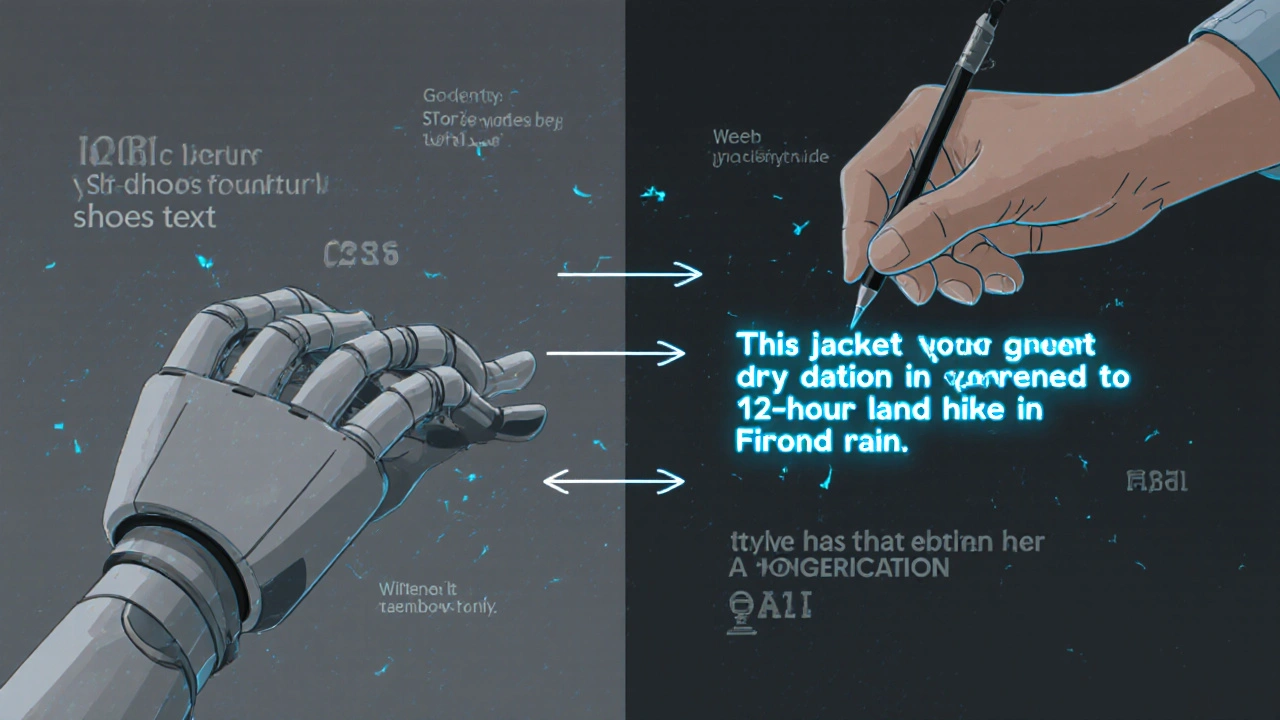Keyword Intent Analyzer
Enter a keyword or search phrase to analyze its likely search intent and get content strategy suggestions. This tool uses principles from the article about how ChatGPT transforms keyword research by focusing on user intent rather than just search volume.
Search Intent Analysis
Example: "List 15 questions people in New Zealand are asking about running shoes in 2025, based on real customer complaints and forum discussions."
SEO isn’t what it was five years ago. The old tricks-keyword stuffing, buying backlinks, spinning articles-don’t work anymore. Google’s algorithms now understand context, intent, and quality like a human reader. And at the center of this shift is ChatGPT. It’s not just another tool. It’s rewriting how marketers think about content, keywords, and user experience.
ChatGPT Isn’t Replacing SEO Experts-It’s Amplifying Them
Some people think AI will make SEO specialists obsolete. That’s not true. What’s changing is the work itself. Instead of spending hours researching keywords or drafting 10 versions of a meta description, you’re now guiding an AI to do the heavy lifting. Your job shifts from writer to strategist.
Think of ChatGPT like a junior analyst who never sleeps, never gets tired, and can pull insights from thousands of pages in seconds. But here’s the catch: it doesn’t know what’s right for your audience unless you tell it. You still need to ask the right questions. You still need to fact-check. You still need to understand your customers’ pain points.
For example, a local plumbing company in Auckland used ChatGPT to generate 50 blog post ideas based on real customer questions from their support tickets. The AI spotted patterns like “why is my water pressure low in winter?” and “how do I fix a leaking tap without calling a plumber?”-topics the company had never thought to write about. Within three months, organic traffic from those posts grew by 147%.
How ChatGPT Transforms Keyword Research
Traditional keyword tools like Ahrefs or SEMrush give you volume and difficulty scores. But they don’t tell you why people are searching. That’s where ChatGPT steps in.
Instead of typing “best running shoes 2025” into a tool, try this prompt:
- “List 15 questions people in New Zealand are asking about running shoes in 2025, based on real customer complaints and forum discussions.”
- “Rewrite these questions as natural, conversational blog titles.”
- “Group these by search intent: informational, commercial, or transactional.”
ChatGPT doesn’t just give you keywords-it gives you context. It understands that someone searching “how to stop my feet hurting after running” isn’t ready to buy. They need advice first. That’s a content opportunity, not a sales pitch.
In 2025, Google rewards content that answers the full question, not just the keyword. ChatGPT helps you build topic clusters around user intent, not just search volume. This is how you rank for long-tail phrases that no one else is targeting.
Writing SEO Content That Actually Converts
Most AI-generated content sounds robotic. That’s because people use it wrong. They ask for “a 1,000-word article on SEO tips” and get generic fluff.
Here’s how to fix it:
- Give it a persona: “Write as if you’re a 35-year-old small business owner in Wellington who’s tired of wasting time on SEO.”
- Give it structure: “Use H2s for each major question, include bullet points for quick tips, and end with a real-life example.”
- Give it constraints: “No jargon. No fluff. No passive voice. Keep sentences under 18 words.”
One e-commerce store selling outdoor gear used this method to rewrite 40 product descriptions. Instead of “durable waterproof material,” they wrote: “This jacket kept me dry during a 12-hour hike in the Fiordland rain. No soggy socks. No shivering.”
Click-through rates jumped 38%. Bounce rates dropped by 29%. Why? Because the content sounded like a real person talking-not a marketing brochure.

Optimizing for People, Not Just Algorithms
Google’s Helpful Content Update rolled out in 2022, but its impact is still growing. Sites that rank now aren’t the ones with the most keywords. They’re the ones that feel human.
ChatGPT can help you pass that test. Try this simple check before publishing any AI-written content:
- Ask: “Would a real person share this with a friend?”
- Ask: “Does this answer the question better than the top 3 results?”
- Ask: “Is there a specific detail here that only someone who’s done this would know?”
If the answer to any of those is “no,” rewrite it. Use ChatGPT to add real examples: “I once helped a client fix their ranking by changing one sentence in their product page. Here’s what they changed…”
Google doesn’t reward perfection. It rewards authenticity. ChatGPT gives you speed. You give it soul.
Fixing Technical SEO with AI
Most people think ChatGPT only writes content. But it’s also great at spotting technical issues.
Copy your site’s top 10 landing pages into ChatGPT and ask:
- “Scan this content for duplicate meta descriptions.”
- “Identify any H1 tags that don’t match the page topic.”
- “Find sentences that are over 30 words and suggest shorter versions.”
- “List all internal links and check if they point to relevant pages.”
One agency in Christchurch used this to audit 200 pages in under an hour. They found 47 pages with mismatched H1s, 12 with no meta descriptions, and 8 that were keyword-stuffed. Fixing those alone boosted their client’s organic traffic by 22% in six weeks.
You don’t need to be a developer to use ChatGPT for technical SEO. You just need to know what to ask.

What ChatGPT Can’t Do (And Why You Still Need Humans)
Let’s be clear: ChatGPT isn’t magic. It doesn’t know your brand voice unless you teach it. It doesn’t understand local regulations. It can’t replace a real customer interview.
Here are the top three things AI still can’t do:
- Build trust-People don’t buy from bots. They buy from brands they believe in.
- Understand nuance-If your audience is Māori small business owners in Tauranga, ChatGPT won’t know the cultural context unless you guide it.
- Adapt to real-time changes-If Google drops a new update tomorrow, ChatGPT won’t know until it’s retrained. You have to monitor and adjust.
Use ChatGPT to handle the repetitive tasks. Save your human brain for strategy, empathy, and creativity.
Getting Started: Your First 3 Steps
If you’re new to using ChatGPT for SEO, start small. Here’s how:
- Run a content audit-Pick your top 5 blog posts. Ask ChatGPT: “Analyze these for readability, keyword density, and user intent. Suggest one improvement per post.”
- Generate 10 topic ideas-Ask: “What are 10 under-covered questions about [your niche] that people in New Zealand are asking?” Use those to plan your next month’s content.
- Test one piece-Write one article using AI, then rewrite the intro and conclusion in your own voice. Track traffic for 30 days. Compare it to your old posts.
Don’t try to automate everything. Start with one task. Master it. Then move to the next.
The Future of SEO Is Human + AI
The best SEO teams in 2025 aren’t the ones with the most tools. They’re the ones who know how to work with AI like a teammate-not a replacement.
ChatGPT handles the grunt work: research, drafting, optimization, and structure. You handle the strategy: tone, trust, localization, and emotional connection.
SEO isn’t dying. It’s evolving. And if you’re not using AI to make your work smarter, faster, and more human-you’re falling behind.
Can ChatGPT replace SEO professionals?
No. ChatGPT automates tasks like research, drafting, and optimization, but it can’t replace human judgment. SEO still requires understanding audience intent, brand voice, cultural context, and real-world feedback. AI speeds up the work-you still need to guide it and make final decisions.
Is AI-generated content penalized by Google?
Google doesn’t penalize content just because it’s AI-generated. What matters is quality and usefulness. If your content is thin, repetitive, or lacks original insight, it won’t rank-whether it was written by a human or AI. The key is adding real value: personal experience, local details, and clear answers to user questions.
How do I make ChatGPT write better SEO content?
Give it clear instructions: specify your audience, tone, and structure. Ask for real examples, avoid jargon, and limit sentence length. Always edit the output to add personality and authenticity. Use prompts like, “Write as a small business owner in Auckland who’s tired of SEO hype,” to get more natural results.
What’s the best way to use ChatGPT for keyword research?
Instead of relying only on keyword tools, ask ChatGPT to generate questions real people are asking. For example: “List 15 questions New Zealanders have about [your product] based on forum posts and customer reviews.” This reveals long-tail, intent-rich phrases that tools often miss. Then match those to your content strategy.
Can ChatGPT help with technical SEO?
Yes. You can paste your page content into ChatGPT and ask it to spot issues like duplicate meta descriptions, mismatched H1 tags, or overly long sentences. It can also suggest internal linking opportunities and flag content that’s too similar to other pages. It’s not a crawler, but it’s a powerful assistant for quick audits.
Start using ChatGPT for SEO today-not because it’s trendy, but because it’s efficient. The businesses that win in 2025 won’t be the ones with the biggest budgets. They’ll be the ones who work smarter.


I am Orlando Beauchamp, a marketing maven with a knack for digital strategies. My expertise lies in creating engaging content that drives brand growth and fosters customer relationships. I've devoted my career to exploring the nuances of online marketing, with a particular focus on social media and SEO. I love to share my insights by writing about the latest trends and techniques in online marketing. Through my articles, I aim to help businesses of all sizes tap into the immense potential of the digital world.